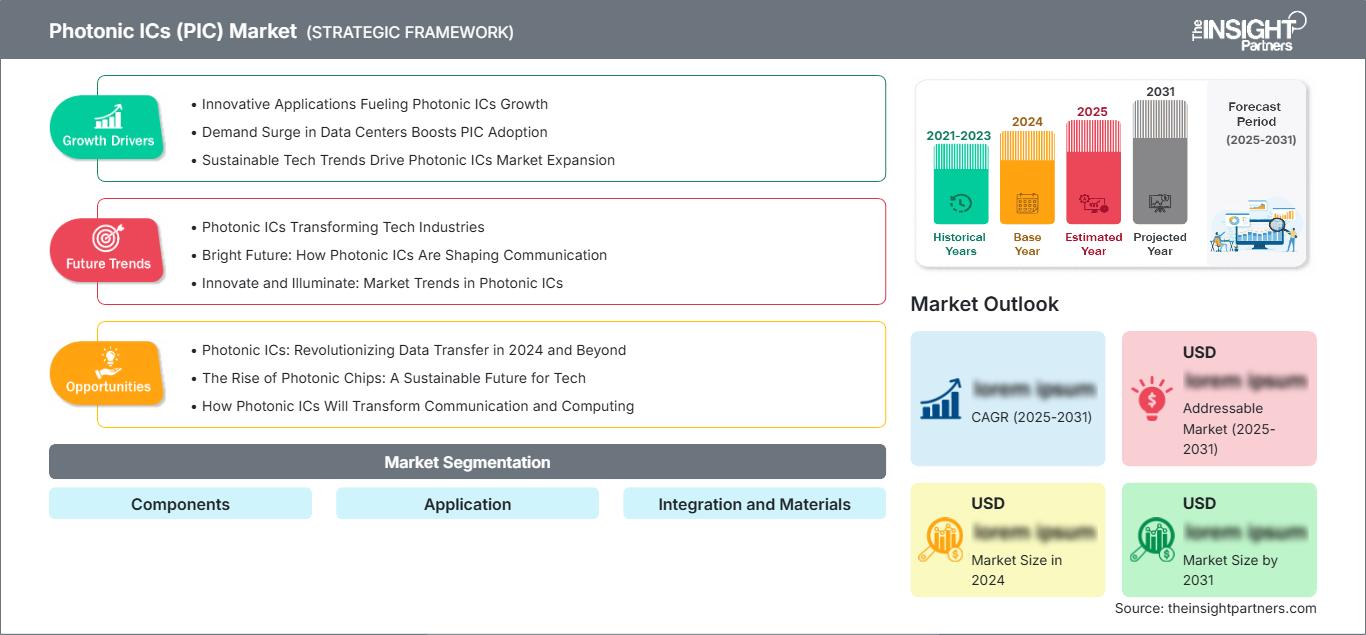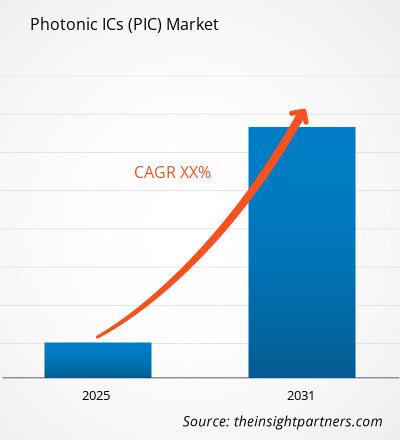Photonische integrierte Schaltkreise (PIC) funktionieren analog zu elektronischen ICs und nutzen Photonen statt Elektronen zur Datenübertragung. Photonen, eine Einheit des Lichts, bewegen sich vergleichsweise viel schneller als andere Datenträger, weshalb sich die Datenübertragungsgeschwindigkeit dramatisch erhöht hat. Der globale Markt für photonische ICs wird voraussichtlich ein bemerkenswertes Wachstum verzeichnen, da er erhebliche Verbesserungen bei Systemgröße, Stromverbrauch, Kosten und Zuverlässigkeit bietet. Auf Basis der Anwendung ist der globale Markt für photonische ICs in Biophotonik, optische Kommunikation, Sensoren, optische Signalverarbeitung und Nanophotonik unterteilt. Der globale Markt für photonische ICs ist weiter auf Basis von Integrationsmethoden segmentiert, die bei monolithischer Integration, Hybridintegration und Modulintegration zum Einsatz kommen. Darüber hinaus ist der globale Markt für photonische ICs auf Basis von Komponenten segmentiert, nämlich: Modulatoren, Laser, Multiplexer/Demultiplexer, Detektoren, optische Verstärker und andere (wie Dämpfungsglieder, Wellenlängenkonverter usw.). Der Markt ist nach Materialien segmentiert, und zwar: Lithiumniobat (LiNbO3), Indiumphosphid (InP), Silizium (Si), Galliumarsenid (GaAs) und Siliciumdioxid auf Silizium. Die anhaltenden Beschränkungen bei elektronischen ICs hinsichtlich der Möglichkeit, mehr Transistoren auf einem einzigen Siliziumsubstrat unterzubringen, zwingen die Industrie dazu, einen Ersatz zu erfinden. Darüber hinaus haben die bestehenden Hauptakteure monolithisch kombinierte InP-basierte photonische ICs entwickelt, die mehr als 600 Komponenten/Funktionen in einem einzigen Chip vereinen. Infolgedessen herrscht auf dem Markt ein enormer Wettbewerb, da jeder einzelne Akteur darauf abzielt, Produkte auf Basis photonischer ICs zu erfinden, die in der Lage sind, große Mengen an Funktionen/Funktionen zu geringen Kosten zu integrieren. Budget- und Größeneinsparungen durch die Integration verschiedener optischer Module, einschließlich Modulatoren, Detektoren und Laser, in ein einziges Paket sind der Hauptfokus der Akteure auf dem Markt für photonische ICs. Steigende Anforderungen an Hochgeschwindigkeitskommunikation und die Entwicklung neuer Anwendungsbereiche, insbesondere in den Bereichen Sensorik, optische Kommunikation und Biophotonik, treiben den globalen Markt für photonische ICs voran. Hohe Energieeffizienz, kostengünstige Herstellung, verbesserte Zuverlässigkeit und hohe Datenübertragungsraten photonischer ICs dürften diesen Markt zusätzlich vorantreiben. Die Nutzung von Photonen für die schnelle Informationsverarbeitung, Berechnung und Datenübertragung bietet gute Aussichten für die Entwicklung des Marktes für photonische ICs. Optische Sensoren sind ein aufstrebendes Anwendungsgebiet in diesem Markt, das in Bereichen wie Luft- und Raumfahrt, Verteidigung, Transport, Energie und Medizin zum Einsatz kommt. Quantencomputing, eine Technologie, die bald kommerzialisiert wird, ist ein weiteres Segment, das eine signifikante Nutzung photonischer ICs verspricht. Photonische ICs werden auch in der Biomedizin eingesetzt, wo InP-basierte photonische ICs für die diagnostische Untersuchung von undurchsichtigem Hautgewebe eingesetzt werden. Optische Kommunikation ist ein führender Anwendungsbereich im Markt für photonische ICs, während Biophotonik und Sensorik die weiteren wichtigen Anwendungsbereiche darstellen. Auch wenn der Input aus dem Segment der optischen Signalverarbeitung derzeit minimal ist, wird mit der Kommerzialisierung des Quantencomputings mit starken Fortschritten gerechnet. Nordamerika ist führend auf dem globalen Markt für photonische ICs, gefolgt von Europa und dem Asien-Pazifik-Raum. Während Nordamerika der wichtigste Markt für photonische ICs ist, wird für den Asien-Pazifik-Raum ein starkes Wachstum erwartet, das Europa und schließlich Nordamerika überholt. Die Entwicklung im Asien-Pazifik-Raum ist hauptsächlich auf die steigende Nachfrage aus den Bereichen optische Kommunikation und Biophotonik zurückzuführen. Der weltweite Markt für photonische ICs ist äußerst uneinheitlich und von der Präsenz einer großen Zahl von Akteuren geprägt. Zu den Top-Playern auf dem Markt zählen Alcatel-Lucent SA, Infinera Corporation, JDS Uniphase Corporation, Huawei Technologies Co. Ltd., Avago Technologies Ltd., Intel Corporation, Agilent Technologies, Ciena Corporation, Emcore Corporation und NeoPhotonics Corporation.
Sie erhalten kostenlos Anpassungen an jedem Bericht, einschließlich Teilen dieses Berichts oder einer Analyse auf Länderebene, eines Excel-Datenpakets sowie tolle Angebote und Rabatte für Start-ups und Universitäten.
Markt für photonische ICs (PIC): Strategische Einblicke

-
Holen Sie sich die wichtigsten Markttrends aus diesem Bericht.Dieses KOSTENLOSE Beispiel umfasst Datenanalysen, die von Markttrends bis hin zu Schätzungen und Prognosen reichen.
Regionale Einblicke in den Markt für photonische ICs (PIC)
Die Analysten von The Insight Partners haben die regionalen Trends und Faktoren, die den Markt für Photonik-ICs (PIC) im Prognosezeitraum beeinflussen, ausführlich erläutert. In diesem Abschnitt werden auch die Marktsegmente und die geografische Lage für Photonik-ICs (PIC) in Nordamerika, Europa, im asiatisch-pazifischen Raum, im Nahen Osten und Afrika sowie in Süd- und Mittelamerika erörtert.
Umfang des Marktberichts zu photonischen ICs (PIC)
| Berichtsattribut | Einzelheiten |
|---|---|
| Marktgröße in 2024 | US$ XX million |
| Marktgröße nach 2031 | US$ XX Million |
| Globale CAGR (2025 - 2031) | XX% |
| Historische Daten | 2021-2023 |
| Prognosezeitraum | 2025-2031 |
| Abgedeckte Segmente | By KomponentenBy AnwendungBy Integration und Materialien |
| Abgedeckte Regionen und Länder |
Nordamerika
|
| Marktführer und wichtige Unternehmensprofile |
|
Dichte der Marktteilnehmer für photonische ICs (PIC): Verständnis ihrer Auswirkungen auf die Geschäftsdynamik
Der Markt für Photonic ICs (PIC) wächst rasant. Die steigende Nachfrage der Endverbraucher ist auf Faktoren wie veränderte Verbraucherpräferenzen, technologische Fortschritte und ein stärkeres Bewusstsein für die Produktvorteile zurückzuführen. Mit der steigenden Nachfrage erweitern Unternehmen ihr Angebot, entwickeln Innovationen, um den Bedürfnissen der Verbraucher gerecht zu werden, und nutzen neue Trends, was das Marktwachstum weiter ankurbelt.

- Holen Sie sich die Markt für photonische ICs (PIC) Übersicht der wichtigsten Akteure
- Historische Analyse (2 Jahre), Basisjahr, Prognose (7 Jahre) mit CAGR
- PEST- und SWOT-Analyse
- Marktgröße Wert/Volumen – Global, Regional, Land
- Branchen- und Wettbewerbslandschaft
- Excel-Datensatz
Aktuelle Berichte
Erfahrungsberichte
Grund zum Kauf
- Fundierte Entscheidungsfindung
- Marktdynamik verstehen
- Wettbewerbsanalyse
- Kundeneinblicke
- Marktprognosen
- Risikominimierung
- Strategische Planung
- Investitionsbegründung
- Identifizierung neuer Märkte
- Verbesserung von Marketingstrategien
- Steigerung der Betriebseffizienz
- Anpassung an regulatorische Trends






















 Kostenlose Probe anfordern für - Markt für photonische ICs (PIC)
Kostenlose Probe anfordern für - Markt für photonische ICs (PIC)